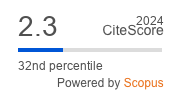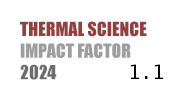THERMAL SCIENCE
International Scientific Journal
Thermal Science - Online First
online first only
Potential of evaporative cooling in the climate of Serbia
ABSTRACT
Evaluating the evaporative cooling potential primarily depends on gaining a detailed and accurate understanding of the local climate. In this study, the potential of evaporative cooling was estimated based on the bioclimatic analysis and psychrometric chart using Climate Consultant software. Bioclimatic charts were developed for 22 locations within a different climatic conditions in Serbia in order to quantify the potential of evaporative air cooling strategies for different regions. Bioclimatic charts are generated by plotting Typical Meteorological Year weather data set on the psychrometric chart along with ranges defined with human thermal comfort models. The software tool demonstrates the effectiveness of Direct and Two-stage Evaporative Cooling for defined comfort model. The percentage reduction in total cooling hours with the help of these systems varies 16.1- 94.9% at the locations considered. The study also indicates that indirect system with vapor-compression second stage can provide adequate comfort cooling with significant savings throughout the cooling season. The obtained results generally recommend the application of evaporative cooling technology in air conditioning in the climatic conditions of Serbia, especially in all types of cooling systems based on fresh air. This can have significant implications for engineers when choosing a combination of cooling strategies which are appropriate for the specific location.
KEYWORDS
PAPER SUBMITTED: 2025-02-05
PAPER REVISED: 2025-03-05
PAPER ACCEPTED: 2025-03-12
PUBLISHED ONLINE: 2025-04-05
- ***, International Energy Agency (IEA), World Energy Outlook - Special Report, IEA, Paris, France, 2015, iea.blob.core.windows.net/assets/8d783513-fd22-463a-b57da0d8d608d86f/ WEO2015SpecialReportonEnergyandClimateChange.pdf
- ***, Ministry of Energy, Development and Environmental Protection of Republic of Serbia, National Renewable Energy Action Plan of the Republic of Serbia, Belgrade, Serbia, 2013, arhiva.mre.gov.rs/doc/efikasnost-izvori/NREAP%20OF%20REPUBLIC%20OF%20 SERBIA%2028_June_2013.pdf?uri=CELEX:32009L0028
- Rawal, R., Shukla, Y., Residential Buildings in India: Energy Use Projections and Savings Potentials, A Report by Centre for Environmental Planning and Technology (CEPT), University and Global Buildings Performance Network (GBPN), India, 2014
- Xuan, Y. M., et al., Research and Application of Evaporative Cooling in China: A Review (I) - Research, Renewable and Sustainable Energy Reviews, 16 (2012), 5, pp. 3535-3546
- Khater, E. S. G., Performance of Direct Evaporative Cooling System Under Egyptian Conditions, Journal of Climatology and Weather Forecasting, 2 (2014), 2, pp. 1-9
- Bom, G. J., et al., Evaporative Air-conditioning: Applications for Environmentally Friendly Cooling, Energy Series, World Bank Technical Paper No. 421, 1999, The World Bank, Washington D. C., USA, 1999
- Chua, K. J., et al., Achieving Better Energy-efficient Air Conditioning - A Review of Technologies and Strategies, Applied Energy, 104 (2013), pp. 87-104
- Duan, Z., et al., Indirect Evaporative Cooling: Past, Present and Future Potentials, Renewable and Sustainable Energy Reviews, 16 (2012), pp. 6823-6850
- Watt, J. R., Evaporative Air Conditioning Handbook, 2nd Ed., Springer Science & Business Media, New York, USA, 2012
- Xuan, Y. M., et al., Research and Applications of Evaporative Cooling in China: A Review (II) - Systems and Equipment, Renewable and Sustainable Energy Reviews, 16 (2012), 5, pp. 3523-3534
- Boukhanouf, R., et al., Investigation of an Evaporative Cooler for Building in Hot and Dry Climates, Journal of Clean Energy Technology, 2 (2014), 3, pp. 221-225
- Kim, M. H., Jeong, J. W., Cooling Performance of a 100% Outdoor Air System Integrated with Indirect and Direct Evaporative Coolers, Energy, 52 (2013), pp. 245-257
- Kovačević, I., Sourbron, M., The Numerical Model for Direct Evaporative Cooler, Applied Thermal Engineering, 113 (2017), pp. 8-19
- Sohani, A., Sayyaadi, H., Design and Retrofit Optimization of the Cellulose Evaporative Cooling Pad Systems at Diverse Climatic Conditions, Applied Thermal Engineering, 123 (2017), pp. 1396-1418
- Kavaklioglu, K., et al., Experimental Investigation and Radial Basis Function Network Modeling of Direct Evaporative Cooling Systems, International Journal of Heat and Mass Transfer, 126 (2018), 2, pp. 139-150
- Li, R., et al., Numerical Method and Analysis of a Tube Indirect Evaporative Cooler, Thermal Science, 26 (2022), 1A, pp. 375-387
- Tariq, R., et al., Recovering Waste Energy in an Indirect Evaporative Cooler - A Case for Combined Space Air Conditioning for Human Occupants and Produce Commodities, Building and Environment, 152 (2019), pp. 105-121
- Wang, L., et al., The Energy and Exergy Analysis of Counter-Flow Regenerative Evaporative Cooler, Thermal Science, 23 (2019), 6A, pp. 3615-3626
- ***, ASHRAE, Thermal Environmental Conditions for Human Occupancy, ASHRAE Std. 55-2010, Atlanta GA, USA, 2010, www.ashrae.org/technical-resources/bookstore/standard- 55-thermal-environmental-conditions-for-human-occupancy
- ***, ISO, ISO 7730:2005 Ergonomics of the Thermal Environment - Analytical Determination and Interpretation of Thermal Comfort Using Calculation of the PMV and PPD Indices and Local Thermal Comfort Criteria, Geneva, Switzerland, 2005, www.iso.org/ standard/39155.html
- ***, ASHRAE, ASHRAE Handbook - Fundamentals 2013, ASHRAE, Atlanta, USA, 2013
- Liggett, R., et al., Climate Consultant 6.0., UCLA, Los Angeles, USA, 2016
- Geiger, R., Klassifikation der Klimate nach W. Köppen (Classification of Climates after W. Köppen, in German), Landolt-Börnstein - Zahlenwerte und Funktionen aus Physik, Chemie, Astronomie, Geophysik und Technik, alte Serie, 3 (1954), pp. 603-607
- Kottek, M., et al., World Map of the Köppen-Geiger Climate Classification Updated, Meteorologische Zeitschrift, 15 (2006), 3, pp. 259-263
- Peel, M., et al., Updated World Map of the Koppen-Geiger Climate Classification, Hydrology and Earth System Sciences, 11 (2007), 5, pp. 1633-1644
- De Castro, M., et al., The Use of a Climate-type Classification for Assessing Climate Change Effects in Europe from an Ensemble of nine Regional Climate Models, Climatic Change, 81 (2007), pp. 329-34
- Beck, H. E., et al., Present and Future Koppen-Geiger Climate Classification Maps at 1-km Resolution, Scientific Data, 5 (2018), 1, pp. 1-12
- Milne, M., Givoni, B., Architectural Design Based on Climate, in: Energy Conservation Through Building Design (Ed. D. Watson), McGraw-Hill, New York, 1979, Ch. 6
- Milovanović, B., et al., Climate Regionalization of Serbia According to Köppen Climate Classification, Journal of the Geographical Institute Jovan Cvijić, 67 (2017), 2, pp. 103-114
- Đorđević, M., et al., Bioclimatic Approach to the Analysis of the Potential of Passive Heating and Cooling Strategies in Serbia, Proceedings, The 6th International Conference Mechanical Engineering in XXI Century, Niš, Serbia, pp. 273-278
- ***, Parallels Software International, Inc., Climate Consultant 6.0, Seattle, USA, 2020, climate-consultant.informer.com/6.0/

